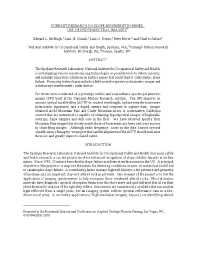Mining Publication: Current Research on Slope Movement in Mines: Use of Hyperspectral Imagery
Original creation date: January 2000
The Spokane Research Laboratory, National Institute for Occupational Safety and Health, is investigating various remote sensing technologies as possible tools to detect, monitor, and mitigate hazardous situations in surface mines that could lead to catastrophic slope failure. Promising technologies include a field-portable spectro-polarimetric imager and a stationary interferometric radar device. Field tests were conducted of a prototype visible and near-infrared spectro-polarimetric imager (SPI) built at the Carnegie Mellon Research Institute. The SPI employs an acousto-optical tunable filter (AOTF) to control wavelength, a phase retarder to measure polarization signatures, and a digital camera and computer to capture data. Images obtained at the Mountain Pass and Castle Mountain mines in southeastern California showed that the instrument is capable of obtaining hyperspectral images of highwalls, outcrops, hand samples and drill core in the field. We have retrieved spectra from Mountain Pass images that closely match those of bastnaesite and have had some success in classifying images. Although radio frequency noise in the data limited spectral classification of imagery, we project that careful alignment of the AOTF should minimize the noise and greatly improve classification.
Authors: EL McHugh, JM Girard, LJ Denes, P Metes, C Sabine
Conference Paper - January 2000
NIOSHTIC2 Number: 20022784
14th International Conference on Applied Geologic Remote Sensing, 2000 Nov Las Vegas, NV :1-8
See Also
- Advances in Remote Sensing Techniques for Monitoring Rock Falls and Slope Failures
- Analysis of Bench Crest Performance at the Yellowstone Mine: A Case Study
- Applications of Ground-Based Radar to Mine Slope Monitoring
- Applications of Ground-Based Radar to Mine Slope Monitoring
- Applications of the Point Estimation Method for Stochastic Rock Slope Engineering
- Assessing and Monitoring Open Pit Mine Highwalls
- Detecting Problems With Mine Slope Stability
- Slope Stability
- Technology News 506 - The Sky is Falling!: NIOSH Releases Safety Video for Surface Mining Operations
- A User's Guide for the Bplane, Bstepp, and Bwedge Computer Programs
- Page last reviewed: 9/21/2012
- Page last updated: 9/21/2012
- Content source: National Institute for Occupational Safety and Health, Mining Program


 ShareCompartir
ShareCompartir
